Articles
This is a short note attempting to offer some perspective to those confused by “Hebrew word picture” proponents. Below are a few diverse images/replicas of ancient inscriptions that employ variations of the “paleo” alphabet. Each example has its unique style or “font,” but nevertheless it is evident they share the same general alphabetic characters. That they are different languages (Moabite, Phoenician, Aramaic, or Hebrew) is not known by the script, but by nuances of vocabulary, syntax, and provenance.
If the paleo “pictographic” interpretation of words/texts has any validity, would it not also apply to these inscriptions? Perhaps some will say, “It only applies to the Bible.” However, these other texts share much vocabulary with the Bible, so the “word pictures” would be the same. Moreover, we only know of the “paleo” alphabet from these and other inscriptions. We don’t have any “paleo-Hebrew” Bibles from the world of ancient Israel. Rather, enthusiasts glean a paleo-style alphabet from inscriptions like these, assign a special meaning to each letter based upon its apparent “pictograph,” and then impose it on the Bible. Finally, they “interpret” the meanings of the letters and combinations as if derived from the Scripture itself.
1. Moabite, 9th Century B.C.
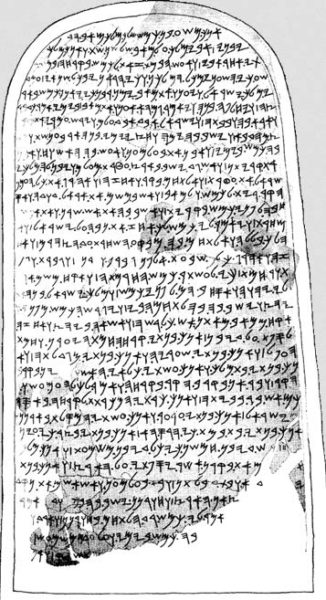
Replica of the Mesha Stele (see Wiki). This non-biblical text contains the name “Israel” and YHWH, and is among the earliest attestations of these names in paleo-script.
2. Phoenician, 9th Century B.C.
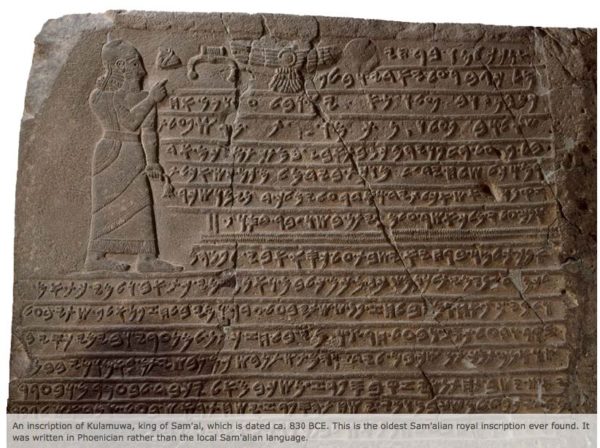
3. Aramaic, 8th Century B.C
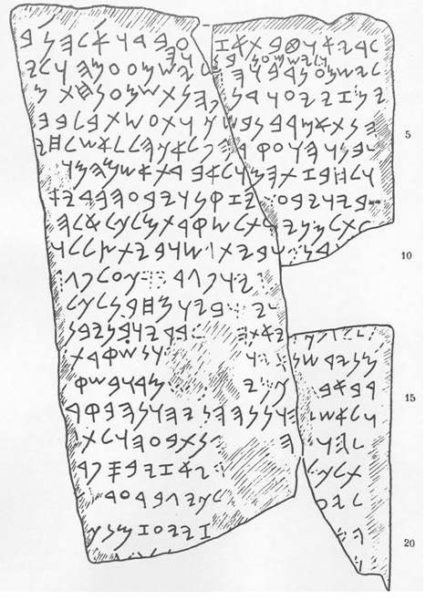
Facsimile of an Aramaic treaty text, Sefire stele II, face B, showing inserted line, ca. 750 B.C. Copied by J. Starcky, in A. Dupont-Sommer, Les inscriptions arameennes de Sefire, 1958. [BIBLE AND SPADE 2 (SPRING-SUMMER-AUTUMN 1982) “In Praise of Ancient Scribes,” by Alan R. Millard.]
4. Hebrew, 8th Century B.C.
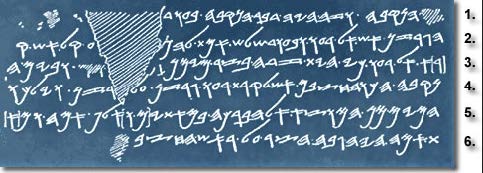
Replica of the Siloam Inscription
5. Hebrew, 2nd – 1st Century B.C. (Dead Sea Scrolls)
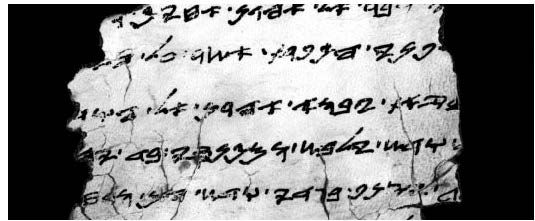
11QpaleoLeviticus(a), photo by Shai Halevi
(http://www.deadseascrolls.org.il/learn-about-the-scrolls/languages-and-scripts)
6. Hebrew, 2nd Century, C.E.
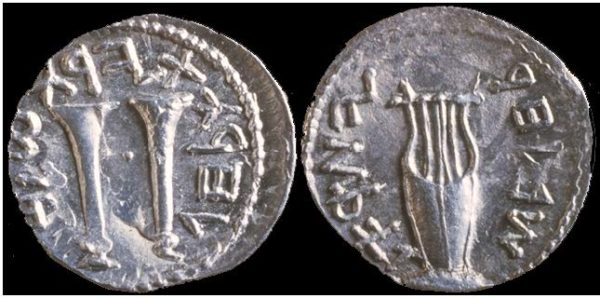
Bar Kokhba coin (http://en.wikipedia.org/wiki/File:Bar_Kokhba_Coin.jpg)
So what can we learn from this?
1. If the letters of the ancient Paleo-Semitic alphabet enjoy a special “pictographic” significance (assumed from their earliest formations and their individual names) that carries over into the meaning of words and texts, then it would not be unique to the Bible. That general principle would transcend any given document written using this alphabet. This “pictography” would apply equally to actual inscriptions like these that use the same alphabet and share core vocabulary with biblical Hebrew. It is preposterous to think we could “decode” these inscriptions using such a methodology.
2. Anyone bold enough to add that these “word pictures” only apply to the Bible needs to come face to face with the reality of their situation. The very notion that each letter has a special “meaning” has been built from data taken from non-biblical inscriptions like the ones given above (apart from the DSS Leviticus fragment, of course). In other words, the Bible itself does not teach us to interpret Hebrew in this manner, and gives us no examples of people doing it. Most importantly, Yeshua Himself neither uses nor teaches us this approach. It must, then, be a clever device promoted by men. But if this is true, we must ask: Why are so many drawn to it?
3. Ancient Israel, Canaan, etc… was for the most part an “oral culture.” Much, much more so that we are today. Slight variances in spelling the same word from language to language is an example of this. What Semitic scholars call “Proto-Semitic phonemes” are expressed with different letters, depending upon the language. For example, the word “earth” in Hebrew is ארץ.In Aramaic, it is ארק or ארע. Another is ישב) Hebrew) is יתב in Aramaic. In these cases, the same phoneme (consonantal sound) is represented differently by different dialects, even when it’s the same word. The same overall alphabet is used. There are numerous other instances of this (and we can compare Phoenician, Ugaritic, and Arabic with Hebrew and Aramaic). It was an “oral world” where written text was secondary to spoken language. In my experience, those most excited about “pictographic” decoding techniques are unlikely to actually do the hard work and learn Hebrew grammar.
4. A note on the “Aleph Tav,” which also has received some sensationalism as of late. The “et” (את (appears in other, non-biblical ancient inscriptions and texts too. Yet does it have the same mysterious meaning outside the Bible? Or, do only its Bible appearances have special meaning? In any case, Yeshua said “I am the Alpha and the Omega…. the beginning and the end, the first and the last, etc…” Shall we now look for Greek texts that have ΑΩ and declare them to have special meaning? What about the “and” in between? Are we at liberty to simply drop it, pretend like it’s not there? And even if we grant it was in Hebrew (and it was NOT.), it would be something like והתו האלף אני… this is not anything like what was suggested twenty-plus years ago by Chuck Missler (I think in his Beyond Coincidence tape and elsewhere) and still others today, like William Stafford (M.A.T.S.), who insist Yeshua meant, “I am the את when it is used in the Hebrew Scripture.” Imagination gone wild.

Rob Vanhoff
Instructor
Rob teaches courses on 2nd Temple Period, Rabbinic Literature, Judaism, Koine Greek, and Aramaic. He has delivered papers at conferences for both Evangelical Theological Society and the Society of Biblical Literature. Rob holds two degrees from the University of Washington: MA, Comparative Religion (2005) and BA, Near Eastern Languages & Civilization, with a minor in Music (2003).